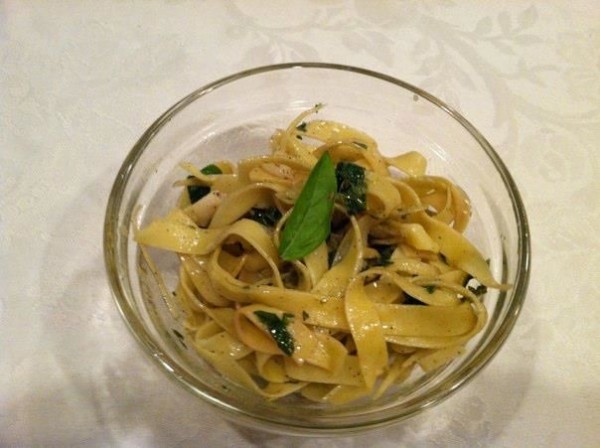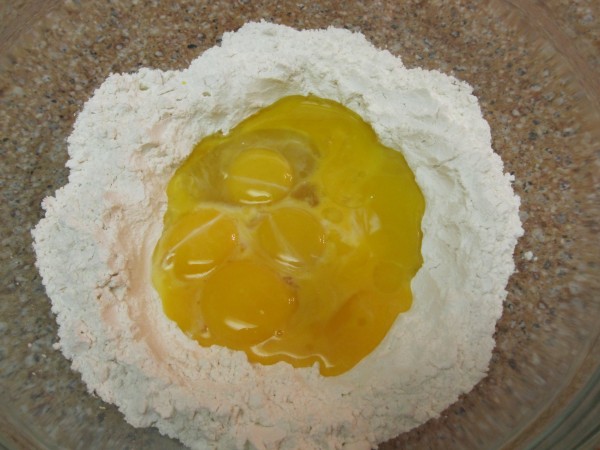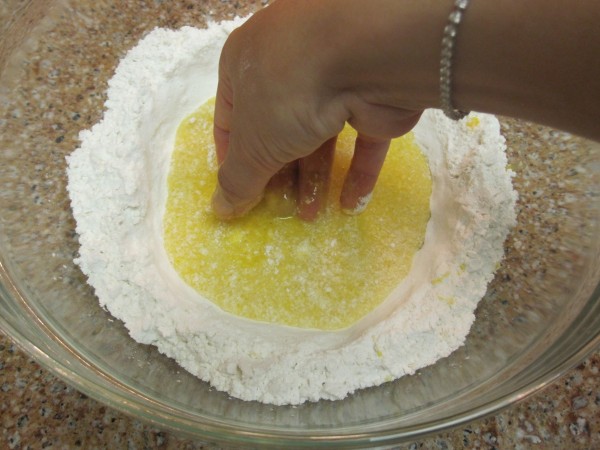After attempting to make French macarons, I had plenty of egg yolks left over (and no cookies!). Sure, I could make ice cream or pudding with them, but I didn’t feel like it. So even though I don’t have a pasta roller, I decided to make pasta dough and roll it out with my rolling pin. When the dough was finished, I was scared to ruin it, so I took my pasta over to my parents’ house, instructing my sister to bring her Kitchenaid pasta-rolling attachment there as well, and we teamed up to serve our family the best pasta dish ever!
There really is nothing like fresh pasta; it’s so unlike the boxed stuff, it was worth the failed macarons, the work and the wait!
We cut our dough into fettuccine and made a simple sauce with garlic, olive oil, fresh basil and a little butter so as not to overpower the delicious pasta, but once you have the fresh pasta, there are endless possibilities!
Seven-Yolk Pasta Dough
from French Laundry Cookbook, via Smitten Kitchen
Ingredients:
- 1 3/4 cups (8 ounces) all-purpose flour
- 6 large egg yolks
- 1 large egg
- 1 1/2 teaspoons olive oil
- 1 tablespoon milk
Directions:
- Mound flour on a board or in a bowl and create a well in the center, pushing the flour to all sides to make a ring with sides about 1-inch wide. Make sure that the well is wide enough to hold all the eggs without spilling.
- Pour the egg yolks, egg, oil and milk into the well. Use your fingers to break the eggs up. Still using your fingers, begin turning the eggs in a circular motion, keeping them within the well and not allowing them to spill over the sides. This circular motion allows the eggs to gradually pull in flour from the sides of the well; it is important that the flour not be incorporated too rapidly, or dough will be lumpy. Keep moving the eggs while slowly incorporating the flour. Occasionally push the flour toward the eggs; the flour should be moved only enough to maintain the gradual incorporation of the flour, and the eggs should continue to be contained within the well. The mixture will thicken and eventually get too tight to keep turning with your fingers.
- When the dough begins thickening and starts lifting itself from the board, begin incorporating the remaining flour by lifting the flour up and over the dough that’s beginning to form and cutting it into the dough. When the remaining flour from the sides of the well has been cut into the dough, the dough will still look shaggy. Bring the dough together with the palms of your hands and form it into a ball. It will look flaky but will hold together.
- Knead the dough by pressing it, bit by bit, in a forward motion with the heels of your hands rather than folding it over on itself as you would with a bread dough. Re-form the dough into a ball and repeat the process several times. The dough should feel moist but not sticky. Let the dough rest for a few minutes while you clean the work surface.
- Dust the clean work surface with a little flour. Knead the dough by pushing against it in a forward motion with the heels of your hands. Form the dough into a ball again and knead it again. Keep kneading in this forward motion until the dough becomes silky smooth. The dough is ready when you can pull your finger through it and the dough wants to snap back into place. The kneading process can take from 10 to 15 minutes.
- Even if you think you are finished kneading, knead it for an extra 10 minutes; you cannot overknead this dough. It is important to work the dough long enough to pass the pull test; otherwise, when it rests, it will collapse.
- Double-wrap the dough in plastic wrap to ensure that it does not dry out. Let the dough rest for at least 30 minutes and up to 1 hour before rolling it through a pasta machine. The dough can be made a day ahead, wrapped and refrigerated; bring to room temperature before proceeding.





